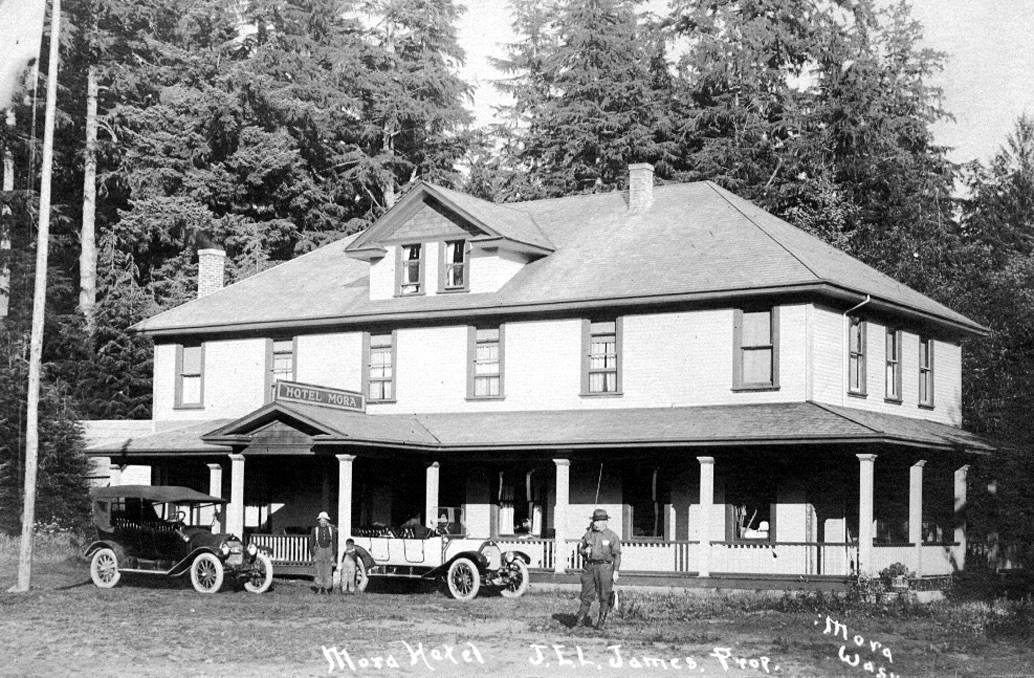With Local Tribes closing their lands to visitors because of COVID-19 and several Forest Service campgrounds shut down Mora and Rialto beach are taking a real hit this summer. It was 57 years ago this month that Mora Campground opened.
In August 1963 the campground opened to rave reviews …it featured 94 locations for tents and/or RV’s and provided fireplaces, tables, and benches and an outdoor theater. The outdoor theater was located near the spot where in 1888 Karon O. Erickson erected a shelter of split cedar timbers and spruce bark and set out to prove up a 160-acre homestead.
A biography written about him says that the forest was dense and the nearest non-native neighbors were on the Quillayute Prairie, except for Dan Pullen, who kept the Washington Fur Co.’s post across the river.
When Erickson went to the Quillayute, the river emptied into the Pacific at Rialto Beach instead of behind James Island. LaPush was located on a lagoon and the company schooner bringing supplies and picking up seal, mink and sea-otter skins would anchor in the cove east of the jetty, in rough weather, it had to move out to sea.
The river was navigable only by canoes and there was no other way into the country except on foot from Pysht. Erickson walked the distance in five days and found a land claim at the junction of the Dickey (Dichodochtedar) River and the Quillayute. He had brought no tools but he crudely erected a structure and dug a hole in the center for a fireplace.
Needing money and supplies Erickson left for San Francisco and worked that winter in a furniture factory and attended school at night to improve his scanty education. He returned to the wilderness the next year and with the help of a fellow homesteader erected a log cabin on a stone foundation. A wrecked vessel at Cape Johnson provided iron bolts, copper and some boards that he used as well.
At the end of the summer, Erickson and his fellow homesteader left a second time to seek employment. They went to Seattle but there had been a fire leaving much of the business district in ashes. So it was back to San Francisco to his old job, where he saved money and made plans to enlarge his home and open a trading post on the Quillayute River.
The problem with Erickson’s idea was that the Washington Fur Company in La Push controlled the business until Pullen made the mistake of claiming a homestead on Tribal land; Pullen was also implicated in a fire that burned much of La Push. Many believed Pullen and two other men, maybe also involving Erickson, deliberately set the fire. Although Pullen denied it, he immediately leveled the area, planted grass, and put up a barbed-wire fence.
Pullen was disposed by the government in 1893.
Erickson would continue to farm and sell eggs and produce to area homesteaders, eventually, a post office was established in 1901 with Erickson naming the settlement Mora after his birthplace in Sweden.
Prior to Erickson’s arrival, a farmer named Frank Balch had established a store and post office under the name Boston.
Erickson married a woman from San Francisco; he was postmaster, storekeeper, and US Commissioner and also put up travelers in the spare room over his store. His wife died in 1907 leaving Erickson with two small children deciding the area was far too isolated to continue living there. He sold the store and post office in 1908 to W. F. Taylor.
Although Erickson had moved to Port Angeles he still saw the prospects of developing a resort on the Quillayute River and he erected the Hotel Mora, opposite his old store property, it had 15 rooms and opened in May 1916 and almost immediately was purchased by J.E.L. James.
Meanwhile, Taylor had transferred his operations to the mouth of the Dickey River. For the next three years, Morse and Sons of Port Angeles maintained a cannery close by. When gas motors came into use Taylor installed a floating service station on a scow and accommodated commercial fishermen.
James also operated a store in connection with his resort, catering to sportsmen and campers. After the hotel burned in 1923 James continued to rent out small cabins on the site.
In 1953 all the area of Mora was incorporated into Olympic National Park. The area had been administered by the Park Service since the period between 1939 and 1941, when the Federal Government had bought out the settlers and placed the land on Public Works Administration status.
The development of public camping facilities was not undertaken until 1963 after buildings for Park staff were built. The road to Rialto was improved and 65 picnic tables and a restroom were installed near the parking lot.



